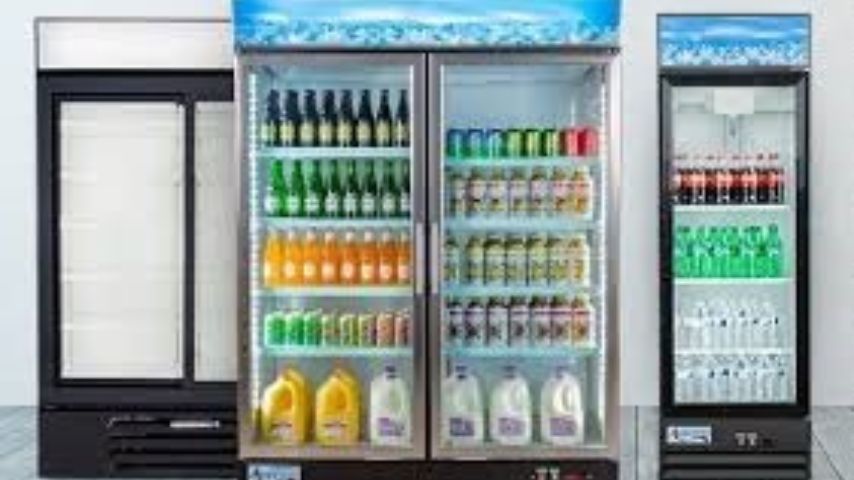Introduction
Commercial fridges play a crucial role in the food service industry by providing essential storage solutions for perishable goods. These refrigeration units are designed to maintain precise temperature controls, ensuring food safety and quality. From small cafes to large-scale restaurants and supermarkets, the reliance on commercial fridges is fundamental to operations.
Define Commercial Fridges
Commercial fridges are refrigeration units specifically designed for storing perishable food items in commercial settings. Unlike domestic refrigerators, these units are larger, more robust, and capable of handling high-volume storage requirements.
Importance in Food Service Industry
In the food service industry, maintaining food safety is paramount. Commercial fridges help businesses adhere to health regulations by preserving food at optimal temperatures, thereby reducing the risk of spoilage and contamination.
Relevance of Energy Efficiency
Energy efficiency is a critical consideration in the operation of commercial fridges. Modern units are designed with energy-saving features to minimize electricity consumption, which not only reduces operating costs but also supports sustainability efforts.
Types and Categories
Commercial fridges come in various types and categories, each suited for different storage needs and spatial requirements within commercial environments.
Walk-in Fridges
Walk-in fridges are large, walk-in storage units designed to accommodate bulk food storage. These units are commonly found in restaurants, hotels, and catering facilities where large quantities of perishable goods need to be stored at controlled temperatures. They offer spacious interiors that allow for easy organization and access to stored items.
Description and Usage
Walk-in fridges typically feature insulated walls, floors, and ceilings to maintain consistent temperature levels. They may include shelving units or racks for organized storage of food products.
Advantages over Standard Units
Compared to reach-in fridges, walk-in units offer greater storage capacity and flexibility in layout design. They are ideal for businesses with high-volume storage needs and frequent deliveries.
Reach-in Fridges
Reach-in fridges are compact, upright units that provide convenient access to stored items without requiring users to enter the fridge space. These units are commonly used in kitchens and retail settings where space is limited, but efficient storage and access are essential.
Compact Design Features
Reach-in fridges feature vertical configurations with shelves or drawers that allow for easy organization of food items. They are available in various sizes to accommodate different storage capacities and space constraints.
Ideal Applications in Restaurants
In restaurant kitchens, reach-in fridges are often used to store frequently accessed ingredients, prepared foods, and beverages. They offer quick access to stored items, making kitchen operations more efficient.
Specifications and Features
Understanding the specifications and features of commercial fridges is essential for businesses to make informed purchasing decisions based on their specific needs and operational requirements.
Energy Star Ratings
Energy Star ratings indicate the energy efficiency of commercial fridges. Units with higher Energy Star ratings consume less energy while delivering optimal cooling performance. Investing in Energy Star-rated fridges can result in significant long-term cost savings on electricity bills.
Importance in Reducing Operating Costs
Energy-efficient fridges help businesses minimize operational expenses associated with electricity consumption. Lower energy consumption also contributes to reduced environmental impact, supporting sustainable business practices.
Compliance with Environmental Standards
Many commercial fridges comply with environmental standards and regulations aimed at reducing greenhouse gas emissions and promoting eco-friendly refrigeration technologies.
Cooling Mechanisms
Commercial fridges employ various cooling mechanisms to maintain consistent temperature levels necessary for food preservation. Understanding these mechanisms is crucial for ensuring the freshness and safety of stored food items.
Detailed Working of Compressors
Compressors are integral to the cooling process in commercial fridges. They compress refrigerant gases to remove heat from the interior of the fridge, cooling the air and maintaining the desired temperature.
Role of Refrigerants in Temperature Control
Refrigerants circulate through the system, absorbing heat from the interior of the fridge and releasing it outside. Choosing refrigerants with low environmental impact is important for minimizing carbon footprint and complying with environmental regulations.
Applications in Various Industries
Commercial fridges serve diverse industries beyond restaurants and food service establishments. Their reliability and functionality make them indispensable in various commercial settings.
Hospitality
In the hospitality industry, commercial fridges are essential for storing perishable ingredients, prepared foods, and beverages. They play a crucial role in complying with food safety regulations and ensuring guest satisfaction through high-quality food service.
Importance in Food Safety Regulations
Hospitality establishments must adhere to stringent food safety regulations to protect guests from foodborne illnesses. Commercial fridges help maintain safe food storage temperatures, preventing bacterial growth and contamination.
Capacity for Large-scale Storage
Large hotels and resorts require extensive refrigeration capabilities to meet the demands of high-volume food preparation and service. Walk-in fridges are particularly suited for these applications due to their spacious interiors and customizable storage options.
Retail
In retail settings, commercial fridges are used for displaying and storing perishable goods such as dairy products, meats, and beverages. Display fridges play a critical role in attracting customers and influencing purchasing decisions.
Display Fridges for Merchandising
Display fridges showcase products in an attractive and organized manner, enhancing visibility and appeal to customers. They are designed with glass doors or open fronts to allow easy access to products while maintaining optimal cooling conditions.
Impact on Customer Purchasing Behavior
The presentation of perishable goods in well-maintained commercial fridges can influence customer perceptions of freshness and quality. Retailers rely on these fridges to preserve product integrity and maximize sales opportunities.
Benefits of Commercial Fridges
Investing in commercial fridges offers numerous benefits for businesses seeking to optimize food storage, operational efficiency, and overall profitability.
Improved Food Preservation
Commercial fridges extend the shelf life of perishable food items by maintaining consistent temperature and humidity levels. Proper storage conditions help preserve food freshness and quality, reducing waste and saving costs.
Extension of Shelf Life for Perishables
Temperature-controlled environments provided by commercial fridges inhibit bacterial growth and enzymatic reactions that cause food spoilage. This prolongs the freshness of fruits, vegetables, dairy products, and meats.
Maintenance of Freshness and Quality
Preserving food freshness enhances the overall dining experience for customers in restaurants and ensures the availability of high-quality ingredients for chefs and culinary professionals.
Enhanced Operational Efficiency
Efficient storage and access to ingredients streamline kitchen operations and improve workflow efficiency in commercial kitchens.
Reduction in Food Wastage
Properly organized storage in commercial fridges minimizes the risk of food spoilage and wastage. Businesses can optimize inventory management and reduce unnecessary purchasing through better control of food inventory.
Streamlined Kitchen Operations
Reach-in fridges and walk-in units allow kitchen staff to access ingredients quickly during food preparation. This reduces downtime and enhances productivity in busy kitchen environments.
Challenges and Considerations
Despite their benefits, commercial fridges present certain challenges and considerations that businesses should address when integrating these units into their operations.
Initial Investment Costs
The upfront cost of purchasing and installing commercial fridges can be substantial, particularly for larger units or those equipped with advanced features. Businesses must budget accordingly and consider long-term cost savings when investing in energy-efficient models.
Budget Allocation Strategies
Businesses can explore financing options or leasing arrangements to manage initial investment costs more effectively. Calculating return on investment based on energy savings and operational efficiencies can justify higher upfront expenditures.
Maintenance Requirements
Regular maintenance is essential for ensuring the optimal performance and longevity of commercial fridges. Businesses should schedule routine inspections, cleaning, and servicing to prevent breakdowns and extend the lifespan of their refrigeration units.
Importance of Regular Servicing
Professional servicing helps identify and address potential issues before they escalate into costly repairs or equipment failures. Maintenance contracts with reputable service providers ensure prompt response times and minimize downtime.
Addressing Common Issues Like Leakage
Leaks in refrigeration systems can lead to inefficiencies, increased energy consumption, and potential food safety hazards. Businesses should promptly address any signs of leakage or condensation to maintain operational integrity and safety.
Latest Innovations and Trends
Technological advancements continue to drive innovation in the commercial refrigeration industry, offering businesses enhanced capabilities and sustainability features.
Smart Fridges
Smart fridges integrate IoT (Internet of Things) technology to provide real-time monitoring and remote management capabilities. These features allow businesses to monitor temperature levels, receive alerts for maintenance issues, and optimize energy usage.
Integration with IoT Technology
IoT-enabled fridges use sensors and connectivity solutions to collect and analyze data on temperature, energy consumption, and operational status. Cloud-based platforms provide access to actionable insights for proactive maintenance and energy management.
Remote Monitoring Capabilities
Remote monitoring enables businesses to monitor multiple fridges across different locations from a centralized dashboard. This enhances operational efficiency by reducing the need for onsite inspections and improving response times to equipment malfunctions.
Energy-efficient Designs
Manufacturers are increasingly focusing on developing energy-efficient commercial fridges that comply with stringent environmental regulations and sustainability standards.
Development of Eco-friendly Models
Eco-friendly fridges use natural refrigerants and advanced insulation materials to minimize environmental impact and energy consumption. These models help businesses reduce their carbon footprint while meeting sustainability goals.
Impact on Sustainability Initiatives
Investing in energy-efficient and eco-friendly fridges supports corporate sustainability initiatives and enhances brand reputation among environmentally conscious consumers. Businesses can demonstrate their commitment to environmental responsibility through responsible purchasing decisions.
Expert Insights and Recommendations
Industry experts provide valuable insights and recommendations for businesses considering the purchase and implementation of commercial fridges.
Advice from Industry Experts
Experts recommend businesses prioritize energy efficiency, reliability, and scalability when selecting commercial fridges. Understanding specific operational requirements and environmental conditions can guide decisions on fridge type, size, and features that best suit business needs.
Tips on Selecting the Right Model
Consulting with refrigeration specialists or suppliers can provide valuable guidance on choosing the appropriate size and configuration of commercial fridges. Consider factors such as storage capacity, energy efficiency ratings, and warranty coverage to make informed decisions.
Importance of Energy Efficiency Ratings
Choosing fridges with high Energy Star ratings ensures optimal energy performance and cost savings over the lifespan of the equipment. Businesses should prioritize models that meet or exceed energy efficiency standards to minimize operational expenses.
Conclusion
In conclusion, commercial fridges are indispensable assets for businesses in the food service and retail industries. They not only ensure food safety and quality but also contribute to operational efficiency and sustainability efforts. From walk-in units for large-scale storage to compact reach-in fridges for convenience, these refrigeration solutions cater to diverse business needs. Embracing technological innovations like IoT-enabled smart fridges and eco-friendly designs further enhances their value in today's competitive market. Businesses that invest in high-quality, energy-efficient commercial fridges can expect to achieve significant cost savings, reduce environmental impact, and enhance overall operational effectiveness.

